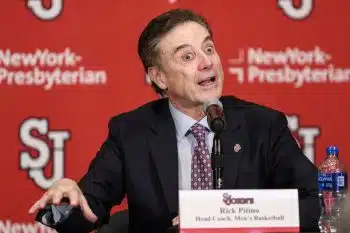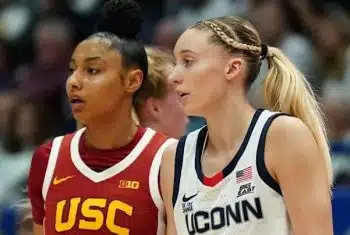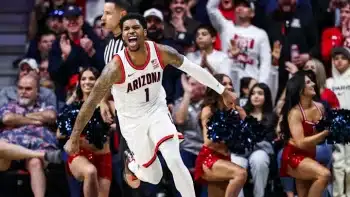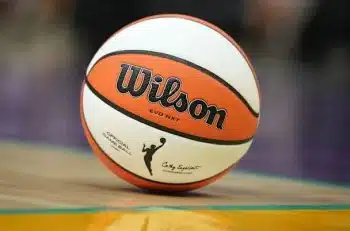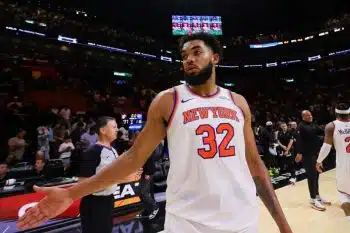NBA
Isaac Okoro represents why this season could be different for the Cleveland Cavaliers
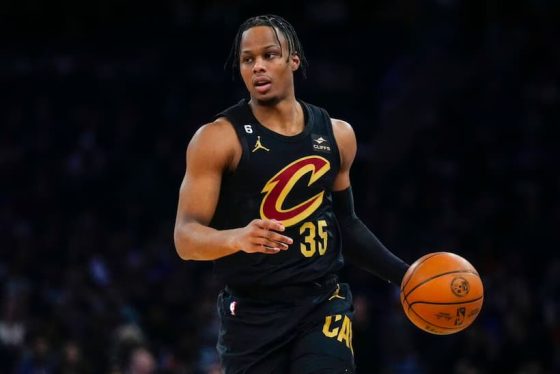
Key Highlights
-
- Isaac Okoro is shooting a career-high 39.3 percent beyond the arc this season
- He’s averaging 3.8 drives per game, a notable increase from last year’s 1.8 per game
- He’s shooting a career-high 37 percent on above-the-break 3-pointers
A year ago, Isaac Okoro and the Cleveland Cavaliers entered the playoffs with high spirits abound. Okoro had just shot 43 percent from deep in 15 games after the All-Star Break (41 percent over his final 51 games, too), while the Cavs won 20 of their last 29 games to nab the No. 4 seed and earn their first playoff berth since 2017-18.
Despite some spacing woes, Cleveland touted the league’s top-ranked defense, in part because of Okoro, who appeared in good form beyond the arc leading into his first taste of playoff hoops.
Instead, Okoro connected on 30 percent of his long balls, was often benched because of his ineffective offense, and the Cavs fell to the New York Knicks in five games, mustering up a paltry 102.2 points per 100 possessions.
Ten months later, the Cavs and Okoro find themselves in a familiar position. They’re second in the East at 36-17 (18-2 over their last 20 games, by the way), and Okoro is shooting a career-high 39.3 percent on triples, including 42 percent since Dec. 12. This time, however, there are plenty of reasons to believe these Midwestern Maulers are much better equipped for a prosperous playoff run, namely the substantial upgrades on the wing.
What’s Different For The Cavs?
Against New York, Cleveland turned to Okoro, Cedi Osman, 36-year-old Danny Green working back from ACL surgery, Dean Wade amid an injury riddled campaign, and Lamar Stevens. Since then, Okoro has expanded his offensive arsenal (more on this soon), and is flanked by Max Strus, a healthy Wade, Georges Niang and Sam Merrill. The Cavs’ versatility and identity on the perimeter have received necessary jolts.
Everyone is either a tremendous perimeter defender (Okoro, Wade) or premier spacer with some extra offensive zest (Strus, Niang, Merrill). Not to mention, Wade is drilling 39.8 percent of his threes and confidently launching them in the process. Last year, most of the wing options were caught in limbo between those two labels, which left Cleveland searching for answers at the fifth starter and sixth man spots during the playoffs.
After ranking 16th in three-point rate (33.8 percent) a season ago, the Cavs are seventh (38.6 percent) this year. Notable injuries to Evan Mobley and Darius Garland in mid-December prompted a long ball revolution. Since Dec. 16 — the day Garland joined Mobley for an extended absence — the Cavs are third in three-point rate (42.1 percent). Even the return of that duo hasn’t amended their principles much. Cleveland is still fifth at 40.1 percent since Jan. 31, when Garland rejoined the lineup (Mobley did the same two days prior).
Really, it’s been a complete overhaul of the shooting profile and tempo. The Cavs are third in rim frequency, 30th in midrange frequency and seventh in three-point frequency. They finished eighth, 11th and 16th in those respective categories last season. Their transition frequency has also spiked from 14.3 percent (19th) to 16 percent (sixth), and they lead the NBA with 1.35 points per transition possession.
Okoro helps pilot these opportunities. He’s fourth league-wide in transition frequency (min. 20 possessions) at 30.5 percent and sits in the 75th percentile in efficiency, producing 1.25 PPP. Give him a runway and he’ll pile-drive to the cup for scores.

The Cavs dial up the pace, bomb threes, and generates plenty of shots inside. They’re 17th in offensive rating on the year, yet rank sixth since their Dec. 16 facelift. This group feels much more conducive to springtime success nowadays.
How Has Isaac Okoro Developed?
A portion of that newfound optimism is Okoro’s half-court developments. He’s morphing from a punishing point-of-attack stopper reliant on corner threes for offensive impact to a malleable ancillary contributor whose defense remains as staunch and pestering as ever.
Last year, 39 percent of his field goals were corner threes (99th percentile among wings) and he drilled 37 percent of them. But such investment in one specific shot narrowed his offensive utility. When they weren’t falling — like they didn’t in the playoffs (33 percent) — it rendered him a tenuous fit around Cleveland’s core four.
This year, 24 percent of his field goals are corner threes and he’s drilling 41 percent of them. Meanwhile, 12 percent of his field goals are above-the-break threes, up from four percent in 2022-23. The lone time that mark’s been higher was his rookie season at 20 percent, when he made 25 percent of them. He’s hit 37 percent of them this year. He’s comfortable in new areas and it allows Cleveland to position him differently. One avenue is not the end-all, be-all for his half-court scoring anymore.
The former Auburn Tiger is turning down some threes to get downhill instead. His 3.8 drives per game are more than double last year’s 1.8. Grant him space by daring him to shoot, and he’ll eat it up with powerfully imposing slashes.
Opponents usually stash lesser defenders on him — content with the outcome of that gambit, knowing it’s historically revolved around corner triples. That’s an outdated belief in 2023-24. He will punish this strategy.

His 59 percent mark at the rim is in the 29th percentile, but it’s still 1.18 points per possession — a very good number. That’s why shots around the rim are so lucrative. Even relatively poor efficiency is still profitable offense on the whole. Plus, he’s drawing shooting fouls on a career-high 16.1 percent of his field goal attempts (92nd percentile), a byproduct of his drive-drive-drive ethos.
Okoro is an adept on-the-move playmaker as well. He’s established a nifty connection with Jarrett Allen and is an alert interior passer. Good stuff happens when the burly forward chisels toward the hoop. Given the surrounding perimeter talent, defenses don’t have many preferred choices than to live with these plays from Okoro. His growth opens up the offense and may help answer some of the looming playoff questions awaiting the Cavs.

The primary issues with shaky-shooting, low-volume offense wings is all the possessions they don’t convert an open three. Sure, a 3-of-7 outing is good, but that positively affects *three* possessions across an entire game. The four misses are wasted chances, let alone all the spacing constraints their lack of gravity places on every other trip down the floor.
Okoro’s improvements ensure his signature isn’t confined to a handful of spot-up reps. There’s much more available this year to exploit defensive apathy than fickle three-pointers.
Nobody else on the roster replicates what Okoro provides defensively. He’s one of the NBA’s foremost point-of-attack stoppers, warping over screens, velcroing to ball-handlers, and refusing to foul or concede space. But it all didn’t prove enough to earn playoff trust, both because of his faults and the limitations of the roster. That isn’t the case anymore.
The Cavs’ frontcourt is no longer composed of three dudes who don’t routinely bend defenses as shooters. Teams may ignore Okoro, yet he’s broadened his skill-set, is sharing the court with fewer vertical-only spacers and can still wrangle with a spectrum of star initiators during his minutes.
Strus’ arrival has enabled Cleveland to avoid units with all three of Okoro, Mobley and Allen. That trio logged 667 minutes together last regular season. It’s down to 34 minutes through 53 games this season; they played 26 minutes together in the playoffs alone last year!
Between his own blossoming and a complementary surrounding context, it’s much easier for his defensive acumen to shine and blend into lineups without sinking the hopes of a fruitful offense. The same applies for the Cavs’ collective defensive acumen. Their defensive priorities don’t have to obstruct their offensive priorities.
Ultimately, the quartet of Garland, Allen, Mobley and Donovan Mitchell must rise to the challenge of the postseason; they all fell short at various points for various reasons against the Knicks. The supporting cast wasn’t built to amplify their efforts, though, Okoro included. Those issues have been addressed.
On the surface, these Cavs are pretty alike to last year: same coach, same core, same top-two defense. Yet so much has changed for the better, Okoro included. They’re all major reasons this year’s playoffs could be starkly different.
